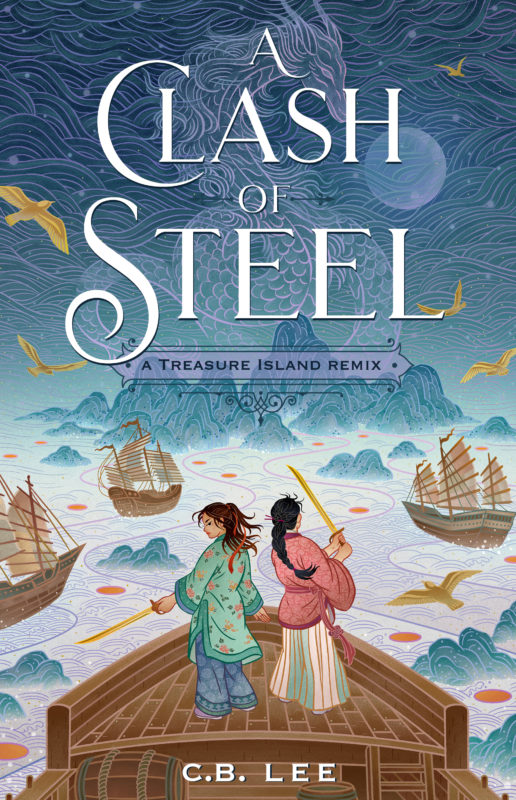
Retellings of Western classics are widespread in fiction, but it’s only as progressive changes have occurred with diversity in publishing that the visibility of such works has extended to include writers of colour. Recent examples by Vietnamese diaspora authors include The Chosen and the Beautiful by Nghi Vo, a retelling of The Great Gatsby, and In the Vanishers’ Place by Aliette de Bodard, a retelling of Beauty and the Beast. These books are intrinsically valuable and creative, but they also serve a cultural purpose: such stories prompt readers to question dominant ideas in the West more strongly through the use of familiar frameworks, allowing authors to add their unique perspectives on existing stories.
A Clash of Steel is a historical adventure novel by Chinese Vietnamese American author C.B. Lee, which encapsulates this purpose. As one of the first books in the new Remixed Classics series from Macmillan, it is loosely inspired by Treasure Island by Robert Louis Stevenson. In a recent interview, the author emphasised that her novel focuses on subverting Western archetypes of pirates associated with the Stevenson’s book, while drawing on her own queer and cross-cultural Asian identity. The story centres on the iconic Chinese pirate queen, Zheng Yi Sao, and is informed by Sino-Vietnamese relations throughout time as well as recent history in terms of the impact of pirates on Vietnamese refugees.
Set in 1826, the protagonists are Xiang, a Chinese girl who has grown up in a small village in Guangdong, and Anh, a Vietnamese girl whose mother is the captain of a trade and fishing ship. The two characters form an unexpected alliance when they discover a secret map, which Xiang had unknowingly inherited from her deceased father. The map shows them the way to treasure belonging to Zheng Yi Sao, who had once dominated the South China Sea with her pirate ships. As Xiang and the crew of the Huyền Vũ ship pursue the treasure, they unearth hidden locations and truths about Zheng Yi Sao as well as Xiang’s own family.
A key driving force throughout the novel is the narrator’s aspirations to explore the wider world. Although Xiang has only ever known life in a quiet village, she is well-educated and therefore has no shortage of dreams. Her primary one at the start of the book is to live in the port city of Canton and learn to run her mother’s tea business, the Pearl House, amongst all the interacting cultures there. With her childhood best friend and many others she’d known now married and having moved away, she feels left behind, yet is also certain that this isn’t what she wants for her own future.
As a young Asian girl, Xiang is an example of someone who, to this day, would be told by society to limit her dreams. She is surrounded by people who hold her back. When Xiang’s mother does tentatively agree to bring her daughter to Canton, her primary goal is to find her a marriage prospect rather than give Xiang new opportunities which she feels are important to her. In spite of this, Xiang remains convinced she wants to take an unconventional path. When she meets Anh, who shares stories of the places she’s travelled to as a ship captain’s daughter, Xiang’s dreams expand “But maybe the Pearl House was just a goal I had because that’s all I knew was possible. I didn’t know a girl like me could sail, could travel, could see the places from the stories.”
Xiang and Anh defy many perceptions of young women during that period from their respective cultures, and it’s these kinds of stories which tend to be lesser-known. In a similar way, the real figure of Zheng Yi Sao is not so well-known in the West, yet she had intimidated existing empires, contrary to expectations of Chinese women. If our conceptions of what marginalised people in history could achieve were broader, perhaps such stories would be more widely known and retold.

A Clash of Steel delves into the fragility of both familial and chosen bonds. From early on, it’s evident that Xiang is desperate to please her mother and craves any hint of her approval. Yet no matter what Xiang does, it’s futile: her mother rarely visits her and pays little attention to her daughter’s growth. Even when Xiang joins the Huyền Vũ ship and agrees with Anh to find the treasure, she clings to the possibility that she might finally prove herself to her mother as a result. “I’d always been taught that blood was everything – that family, where you came from, defined who you could be.”
Yet on board the ship, Xiang witnesses the warm mother-daughter relationship between Anh and Captain Hoa, and finds herself amongst a crew which “feels like a family, with years and years of intimacy and affection and teasing.” When Captain Hoa praises her, she’s grateful and surprised. She realises there may be opportunities for finding the love and acceptance she yearns for, albeit not within her immediate family.

Stories about ‘found family’ and misfit groups are common in adventure stories. Where A Clash of Steel goes further is in its examination of the nuances of the bonds which arise entirely out of choice, and how Xiang grapples with the authenticity of the connections she is forced to rely on. Anh initially betrays Xiang’s trust by stealing her pendant, only returning it when she needs help in decoding the map. Xiang undergoes a poignant struggle throughout the story in trying to untangle the pragmatic basis of their relationship with her growing affection for Anh.
As for Anh, who has long lived amongst the crew and their struggles to make a living, she is sceptical of how much friendships really matter in the brutal world and warns Xiang against being overly trusting:
“You think you can live on love? You think love will feed you or put a roof over your head? Love doesn’t mean anything.” She lets go of my hands now, taking a step back, staring at me as she clenches her hands into fists.
“But your crew—”
“You think of any of them wouldn’t turn on the captain if the price was right enough? On you?”
I think of the promises we made to each other, and I wonder why she’s saying this now, why it hurts so much.
These conflicting worldviews contribute to the strains which arise in Xiang and Anh’s relationship throughout the book. Yet ultimately they overcome this as their relationship grows into a romantic one, suggesting that while doubts may arise between those of different backgrounds, people can make lasting commitments to each other out of love.
In the author’s note, C.B. Lee shares the story of her mother’s journey as a refugee from Vietnam, and stories from her family and other refugees’ encounters with pirates: ranging from pirates who tricked them and attacked them, to those who helped save particular boats. She also mentions that her mother had been fearful of pirates before boarding the boat, but had taken the risk regardless because “the dangers of the sea were far preferable to the dangers on land.”
In A Clash of Steel, CB Lee unpacks the moral ambiguity surrounding pirates, adding context to various characters’ actions, showing the impact of external forces on their decisions. For example, there’s a quiet scene where Captain Hoa reveals that she’d spent a few months as a pirate in Zheng Yi Sao’s fleet. Xiang, initially stunned, realises they share similar viewpoints; the two of them go on to discuss the inequality enforced by the Qing empire and other leaders on people in poverty in China and Việt Nam, such as the restrictions on trade for sailors like Captain Hoa: “Surely you would not begrudge anyone who would leave the society that turned its back on those it swore to protect?”
When Zheng Yi Sao herself then appears, it’s revealed that even she had gone through her own period of desperation when her allies turned away from her, and she was forced to make difficult decisions on how to preserve her legacy. Her ruthlessness is only emphasised as the book progresses, but her motivations are understandable, although ultimately unsympathetic ones.
Towards the end of the story, it’s clear that what distinguishes Zheng Yi Sao from Captain Hoa, Xiang, and Anh is that the latter three choose love and loyalty to others, rather than forsaking them for material treasures as the pirate queen does. It’s an echo of the significance of the former in the author’s own heritage: CB Lee describes how the Chinese and Vietnamese roots in both sides of her family overcame much tragedy and suffering, yet were “brought together by love and the desire to build something new.” And just as formidable women like Zheng Yi Sao have always existed, so too has queer love, like that shared between Xiang and Anh.
I was originally drawn to A Clash of Steel out of curiosity regarding Zheng Yi Sao, who I was intrigued by and wished to discover more about. After reading, I found the book most memorable for the resolute protagonists and how they connect with each other amidst challenging external circumstances drawn from history. The book integrates coming of age experiences and well-known archetypes of pirates and ‘found family’ into a story that would be particularly resonant for queer Asian readers, whose love and aspirations it affirms.
A Clash of Steel
by C.B. Lee
Feiwel & Friends, $18.99
Contributor’s Bio
 Wendy Chen is a writer and reviewer based in Sydney, Australia. Her short fiction has appeared in the anthology Meet Me at the Intersection (Fremantle Press, 2018), and she is a blog contributor at the science fiction and fantasy website Tor.com. You can find more of her book recommendations on Instagram @writteninwonder_
Wendy Chen is a writer and reviewer based in Sydney, Australia. Her short fiction has appeared in the anthology Meet Me at the Intersection (Fremantle Press, 2018), and she is a blog contributor at the science fiction and fantasy website Tor.com. You can find more of her book recommendations on Instagram @writteninwonder_


